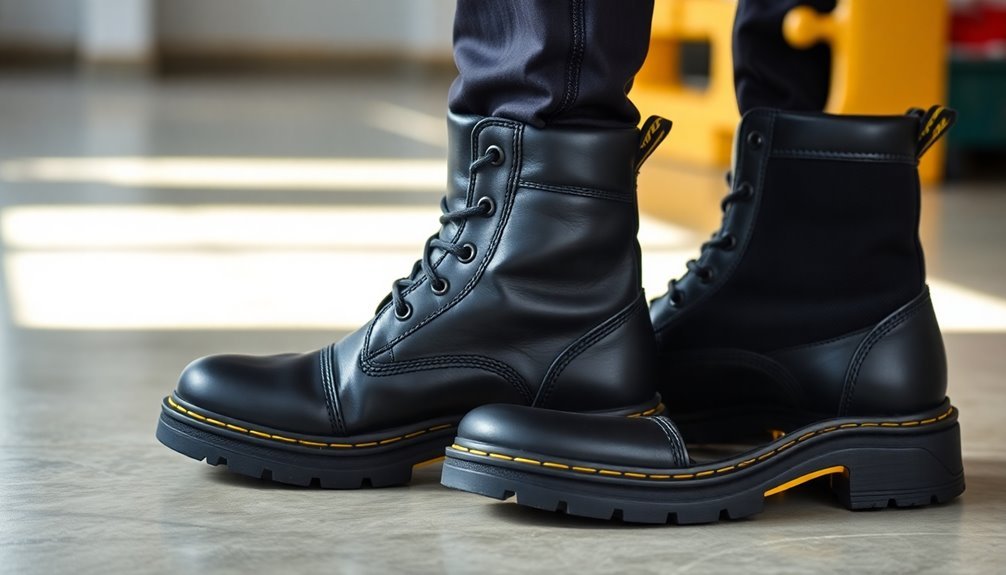You'll find top-rated ESD safety shoes essential for electrical work protection, with models like the Timberland PRO Static Dissipative series, KEEN Utility Atlanta Cool, Reebok Work Sublite Cushion, Skechers Flex Advantage, and New Balance Static Dissipative leading the pack. These shoes meet vital EN ISO 20345 and ASTM F2413-18 SD 35 standards while offering superior comfort through breathable materials and cushioned soles. Each model provides reliable static dissipation, protecting you from electrical hazards in sensitive work environments. With proper ESD footwear being critical for workplace safety, understanding the key features of these top performers will help guarantee your best protection.
ESD Safety Requirements

When working with sensitive electronic components, understanding and following ESD safety requirements is essential to prevent costly damage and potential hazards.
You'll need to confirm you're working in a properly designated ESD Protected Area (EPA) that's clearly marked and equipped with static-safe workstations. Even brief exposure to thousands of volts can occur from simply walking across carpeted areas.
Your attire plays a vital role in maintaining ESD safety. You must wear a grounding wrist strap or ankle strap, along with a closed smock made of dissipative materials.
Don't forget to wear ESD-safe gloves and use anti-static mats at your workstation. You'll also need to regularly test your equipment using ground/polarity testers to verify your workspace remains ESD-safe.
When handling sensitive components, you should only work on static dissipative surfaces that are connected to a common point ground system.
Remember to handle devices by their edges or frames, and limit your movements to prevent static buildup.
You'll need to maintain proper humidity levels between 30% and 70% in your work area.
For component transportation, always use specialized packaging with conductive foam to confirm protection during movement between locations.
Top Rated Static Dissipative Shoes
Several top-rated static dissipative shoes stand out for their exceptional combination of safety features and comfort. You'll find these shoes equipped with conductive rubber or polyurethane outsoles infused with carbon or metallic particles, ensuring efficient static dissipation within the critical resistance range of 1 x 10^6 to 1 x 10^8 ohms.
Leading models offer versatile style options, from casual oxfords to professional dress shoes, without compromising their essential safety features. Quality ESD footwear often includes a Bootbed™ Dual Layered memory foam footbed for enhanced comfort during extended wear. These shoes create a reliable conductive path to the ground, effectively preventing static buildup that could damage sensitive equipment or cause discomfort to wearers.
When you're selecting top-rated ESD shoes, look for ones that comply with ASTM F2413-18 SD 35 standards and match your industry's specific requirements.
The best options provide durability while maintaining consistent static dissipation properties throughout their lifecycle. Whether you're working in electronics manufacturing, aerospace facilities, or data centers, you'll want shoes that balance protection with comfort.
Top manufacturers achieve this by using high-quality conductive materials that meet stringent safety standards while providing the necessary support for long work shifts.
Comfort and Durability Features

A well-designed ESD shoe balances both safety and wearer experience through its comfort and durability features. You'll find that quality ESD footwear incorporates lightweight materials and breathable designs to reduce fatigue during long shifts, while cushioned insoles and flexible soles support your natural foot movement throughout the day.
When it comes to durability, you'll want to look for shoes made with full-grain leather or robust synthetics that can withstand daily wear and tear. The composite toe caps provide essential protection without adding excessive weight to the footwear.
The best ESD shoes feature high-quality outsoles made from rubber or TPU, offering excellent traction while resisting abrasion. You'll also benefit from moisture-wicking linings that keep your feet dry and comfortable during extended wear.
For top performance and longevity, you'll appreciate reinforced stitching and easy-to-clean surfaces that simplify maintenance.
These durability features work alongside ergonomic designs that guarantee a snug fit without constraining your toes or causing discomfort around the sides of your feet.
Safety Certification Standards
Worldwide safety standards dictate the testing and certification requirements for ESD safety shoes. In Europe, you'll need to look for EN ISO 20345 certification, which is the primary standard for protective footwear. Testing involves proper contact resistance measurement through copper plates and electrodes under controlled conditions.
The EN 61340-5-1 standard specifically measures the contact resistance between person, shoe, and ground, while EN 61340-4-3 tests these properties in controlled laboratory conditions.
In the US, you'll find different certifications. ASTM 2412-05 sets the minimum requirements for protective footwear, while ASTM labeling includes specific designations like SD-100 for static dissipative properties. Though OSHA doesn't mandate electrical safety shoes, they follow ANSI and ASTM guidelines.
When selecting ESD shoes, you'll want to check their safety classification. S3-rated shoes offer the most extensive protection, including electrical insulation, impact resistance, and puncture protection.
You'll find three main types: conductive footwear for ignition hazard protection, dielectric footwear for isolation in step-potential environments, and static dissipative footwear that reduces static buildup while maintaining high resistance.
Look for CE labeling on European products and appropriate ASTM designations on US products to guarantee compliance.
Price and Value Comparison

Quality ESD safety shoes typically range from £95 to £130 before tax in the UK market. All ESD footwear must maintain electrical resistance values between 7.5 x 10^5 to 3.5 x 10^7 ohms to meet safety standards. When you're comparing prices, you'll notice that features like BOA lacing systems and additional certifications can impact the cost.
The Helly Hansen W Luna 2, priced at £95 excluding tax, represents the entry point for quality ESD footwear, while the Reebok Safety FE4 sits at the premium end at £125.88 before tax.
Consider these value factors when making your selection:
- BOA-equipped models like the Kensington Low ESD and Chelsea EVO 2 command higher prices (£116.38 and £104.50 respectively) due to their advanced closure system.
- Metal-free designs, like the Reebok FE4, typically cost more but offer additional safety benefits and lighter weight.
- The difference between S1P and S3 ratings affects pricing, as seen in the Chelsea EVO 2 variants (£104.50 for S1P vs £106.88 for S3).
Your investment in ESD safety footwear should balance your specific workplace requirements with your budget. While higher-priced options often include additional features, you'll find reliable protection even in the more economical choices that meet basic ESD safety standards.
Frequently Asked Questions
Can I Wash ESD Shoes Without Damaging Their Static-Dissipative Properties?
You can wash your ESD shoes safely by using neutral detergent, avoiding high temperatures above 40°C, and gentle cleaning methods. Don't brush vigorously or use harsh chemicals to maintain static-dissipative properties.
How Often Should ESD Shoes Be Replaced for Optimal Safety Performance?
You'll need to replace your ESD shoes every three months for strict requirements, or after 200 hours of wear. Always check for visible damage and test resistance regularly – replace them if they fail resistance testing.
Do ESD Shoes Work Effectively on Carpeted Surfaces?
Yes, your ESD shoes will work effectively on carpeted surfaces, but only if you're using static-dissipative carpet. Regular carpet can generate static, so you'll need specialized ESD flooring for best performance and safety.
Can Regular Insoles Be Used as Replacements in ESD Shoes?
No, you can't use regular insoles in ESD shoes. You must only use original or manufacturer-approved ESD insoles. Using standard insoles will void the static protection and put your safety at risk.
Are ESD Shoes Water-Resistant While Maintaining Their Static-Dissipative Capabilities?
Yes, your ESD shoes can be water-resistant while maintaining static dissipation. You'll find them made with waterproof materials like Goretex liners and treated leather, but you'll need regular maintenance to keep both properties effective.
In Summary
When you're working with electrical equipment, don't compromise on safety footwear. Choose ESD shoes that match your workplace requirements, comfort needs, and budget. While prices vary, investing in quality static dissipative shoes will protect you and sensitive equipment. Remember to check for proper certification standards and replace your shoes when they show wear. Your feet and safety deserve the best protection available.





Leave a Reply